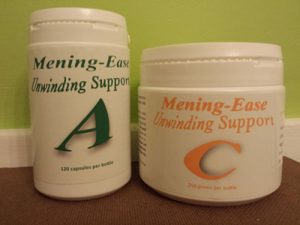Vitamin C and the Health of Your Bones and Brain
The ultimate guide to Vitamin C supplementation
Vitamin C – an essential nutrient
Vitamin C mostly has a reputation for improving immune function and preventing or curing common colds. Common advice includes loading up on Vitamin C during the winter months in order to dodge germs and bugs. Yet advice varies widely on what the correct dosage is. In this post we will discuss what Vitamin C is, what it does, how it keeps the body healthy, and above all what all of this has to do with bones and nerves and why Vitamin C is important during your Unwinding journey.
Vitamins serve highly specific functions within the human organism. They play a key role in vital metabolic and regenerative processes. In order to stay healthy, the human body needs a regular supply of vitamins and other essential nutrients such as minerals, fatty acids, and amino acids. Essential nutrients cannot be created by the organism itself (or, at least not regularly in adequate amounts). Therefore they need to be supplied from external sources such as dietary intake or sunlight exposure. Inadequate intake may result in disease. Vitamin C is such an essential nutrient – the body cannot supply it by itself and it needs to be supplied through external sources.
Vitamin C – what is it?
Vitamin C is also known as L-ascorbic acid. It is a water-soluble vitamin. This means it is taken to the body’s tissues but it is not stored in the body. Water-soluble vitamins are easily excreted through the urine. Vitamin C levels can be determined via a simple blood test. Results can show mild, moderate, or severe deficiency. Severe deficiency is classified as anything less than 10mg per day.
What most people don’t realise is that Vitamin C cannot function by itself. In order to get transported into the cells, there needs to be an adequate level of Zinc. Many Vitamin C supplements do not contain any Zinc, or not enough Zinc. Most Vitamin C supplements contain the vitamin in the form of ascorbic acid. Often, there is a combination of other mineral ascorbates, including calcium ascorbate, magnesium ascorbate, potassium ascorbate, and – ideally – zinc ascorbate.
Vitamin C is found in fruits and vegetables. Citrus fruits, tomatoes and tomato juice, potatoes, broccoli, green peppers, kiwi fruit, strawberries, Brussels sprouts, and cantaloupe all contain high levels of vitamin C.
Why is Vitamin C important?
Vitamin C is vital to keep the body healthy. It is involved in the production of collagen, which is needed for skin and gums and connective tissue repair. Vitamin C plays an active role in wound healing. It is also an important antioxidant and has been shown to interact with and regenerate other antioxidants such as Vitamin E. It may help prevent the onset of certain types of cancer, cardiovascular disease, atherosclerosis, diabetes, and neurodegenerative diseases in which oxidative stress plays a role. It has important immune functions; and it improves the absorption of plant-based iron (nonheme iron).
More recently, research has shown that Vitamin C plays a vital role in the following areas:
- It plays an active role in nerve function related to thinking processes and nerve signalling. It also plays a role in the regeneration of nerve tissue.
- It may be beneficial in addressing depression and suicidal behaviour.
- Parkinson’s Disease patients were found to have low levels of Vitamin C.
- It plays an active role in maintaining healthy bone density levels. It may therefore be beneficial in preventing osteoporosis.
- Studies in mice showed that Vitamin C deficiency caused severe defects in bone formation.
- It activates B vitamins and folic acid (both vital for the formation of healthy cells, and especially important for pregnant women).
- It reduces the severity of allergic reactions and helps fight off infections.
Acute Vitamin C deficiency leads to scurvy. Symptoms can appear within one month of consuming little or no Vitamin C (below 10mg/day). Symptoms include fatigue, general malaise, and inflamed gums. Later on, collagen production slows down, which means connective tissues become weak. This can cause bleeding, joint pain, poor wound healing, tooth loss, corkscrew hairs, and depression. Untreated, scurvy is fatal.
Recommended daily allowance
There is considerable debate among scientists concerning adequate daily intake of essential nutrients in general, and official guidelines are frequently subject to change. Safe nutrient levels were established for different populations, taking into consideration factors such as age, gender, weight/height, health/fitness status, nutritional preference (vegetarianism/veganism), and latitude. This has led to constant refinement of the recommended dietary allowance.
The health effects of Vitamin C intake between 250mg and 10g per day have been studied extensively. As is often the case with medical studies, the results were varied, depending primarily on dosage and short- or long-term supplementation. In general, the health benefits outlined above have been found.
There seem to be no detrimental effects related to high dosages of Vitamin C. It is not toxic, and excess levels are excreted via the urine. Common side-effects of over dosage may include nausea and gastro-intestinal upset.
No guidelines exist for infants. Children 1 year and older are recommended 400mg per day. Adults are recommended 2000mg per day.
Check out our vitamin range
At PPWC we are invested in the health of your bones and nervous system in particular. We have formulated our own range of supplements, called Mening-Ease A and Mening-Ease C. Our aim is to help your body with the Unwinding process produced by Advanced Biostructural Correction™, which partly relies on your body’s ability to remodel bone and cartilage. Targeted nutrition may facilitate this. When we formulated the Mening-Ease range, we carefully looked at how different vitamins work together. The “C”-range therefore includes various mineral ascorbates, as well as Zinc. Without Zinc, Vitamin C cannot get into the cells.
Ultimately, however, it must be kept in mind that supplementation is no substitute for a balanced diet, exercise, and a healthy lifestyle. This should include sufficient intake of fruit/vegetable and fish/meat rather than highly processed packaged foods. Pregnant/breastfeeding women generally have higher daily requirements than the remaining population. If in doubt, ask your Advanced Biostructural Correction™ practitioner or your GP before consuming vitamin supplements.
References:
[1] Vitamin C Fact Sheet. NIH National Institutes of Health, Office of Dietary Supplements. https://ods.od.nih.gov/factsheets/VitaminC-HealthProfessional/
[2] Li Y, Schellhorn HE. New developments and novel therapeutic perspectives for vitamin C. J Nutr 2007;137:2171-84. https://www.ncbi.nlm.nih.gov/pubmed/17884994
[3] Carr AC, Frei B. Toward a new recommended dietary allowance for vitamin C based on antioxidant and health effects in humans. Am J Clin Nutr 1999;69:1086-107. https://www.ncbi.nlm.nih.gov/pubmed/10357726
[4] Frei B, England L, Ames BN. Ascorbate is an outstanding antioxidant in human blood plasma. Proc Natl Acad Sci U S A 1989;86:6377-81. https://www.ncbi.nlm.nih.gov/pubmed/2762330
[5] Jacob RA, Sotoudeh G. Vitamin C function and status in chronic disease. Nutr Clin Care 2002;5:66-74. https://www.ncbi.nlm.nih.gov/pubmed/12134712
[6] Gershoff SN. Vitamin C (ascorbic acid): new roles, new requirements? Nutr Rev 1993;51:313-26. https://www.ncbi.nlm.nih.gov/pubmed/8108031
[7] Weinstein M, Babyn P, Zlotkin S. An orange a day keeps the doctor away: scurvy in the year 2000. Pediatrics 2001;108:E55. https://www.ncbi.nlm.nih.gov/pubmed/11533373
[8] Du J1,2, Zhu M1, Bao H1, Li B1, Dong Y1, Xiao C1, Zhang GY2, Henter I3, Rudorfer M4, Vitiello B4. The Role of Nutrients in Protecting Mitochondrial Function and Neurotransmitter Signaling: Implications for the Treatment of Depression, PTSD, and Suicidal Behaviors. Crit Rev Food Sci Nutr. 2016 Nov 17;56(15):2560-2578. https://www.ncbi.nlm.nih.gov/pubmed/25365455
[9] Covarrubias-Pinto A1,2, Acuña AI3,4, Beltrán FA5,6, Torres-Díaz L7,8, Castro MA9,10. Old Things New View: Ascorbic Acid Protects the Brain in Neurodegenerative Disorders. Int J Mol Sci. 2015 Nov 27;16(12):28194-217. https://www.ncbi.nlm.nih.gov/pubmed/26633354
[10] Medeiros MS1, Schumacher-Schuh A1, Cardoso AM2, Bochi GV3, Baldissarelli J2, Kegler A2,4, Santana D4, Chaves CM4, Schetinger MR2, Moresco RN3, Rieder CR1, Fighera MR2,4. Iron and Oxidative Stress in Parkinson’s Disease: An Observational Study of Injury Biomarkers. PLoS One. 2016 Jan 11;11(1):e0146129. doi: 10.1371/journal.pone.0146129. eCollection 2016. https://www.ncbi.nlm.nih.gov/pubmed/26751079
[11] Figueroa-Méndez R1, Rivas-Arancibia S1. Vitamin C in Health and Disease: Its Role in the Metabolism of Cells and Redox State in the Brain. Front Physiol. 2015 Dec 23;6:397. https://www.ncbi.nlm.nih.gov/pubmed/26779027
[12] Rivas A1, Romero A, Mariscal-Arcas M, Monteagudo C, López G, Lorenzo ML, Ocaña-Peinado FM, Olea-Serrano F. Association between dietary antioxidant quality score (DAQs) and bone mineral density in Spanish women. Nutr Hosp. 2012 Nov-Dec;27(6):1886-93. https://www.ncbi.nlm.nih.gov/pubmed/23588435
[13] Kim W1, Bae S2, Kim H2, Kim Y2, Choi J2, Lim SY3, Lee HJ2, Lee J2, Choi J2, Jang M2, Lee KE4, Chung SG5, Hwang YI2, Kang JS2, Lee WJ2. Ascorbic acid insufficiency induces the severe defect on bone formation via the down-regulation of osteocalcin production. Anat Cell Biol. 2013 Dec;46(4):254-61. https://www.ncbi.nlm.nih.gov/pubmed/24386598
[14] Chambial S1, Dwivedi S1, Shukla KK1, John PJ2, Sharma P1. Vitamin C in disease prevention and cure: an overview. Indian J Clin Biochem. 2013 Oct;28(4):314-28. https://www.ncbi.nlm.nih.gov/pubmed/24426232
[15] Radimer K, Bindewald B, Hughes J, Ervin B, Swanson C, Picciano MF. Dietary supplement use by US adults: data from the National Health and Nutrition Examination Survey, 1999-2000. Am J Epidemiol 2004;160:339-49. https://www.ncbi.nlm.nih.gov/pubmed/15286019






